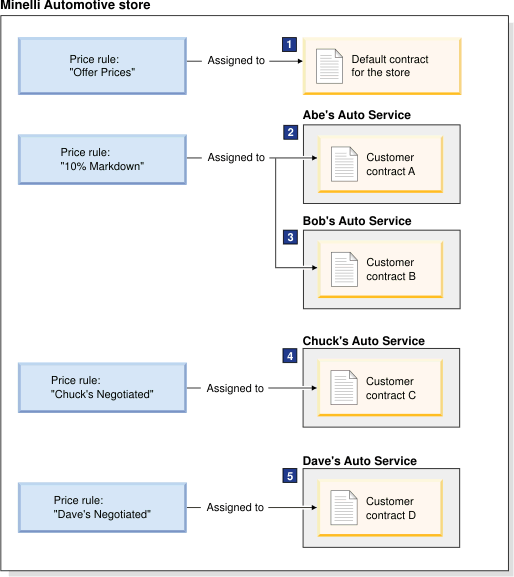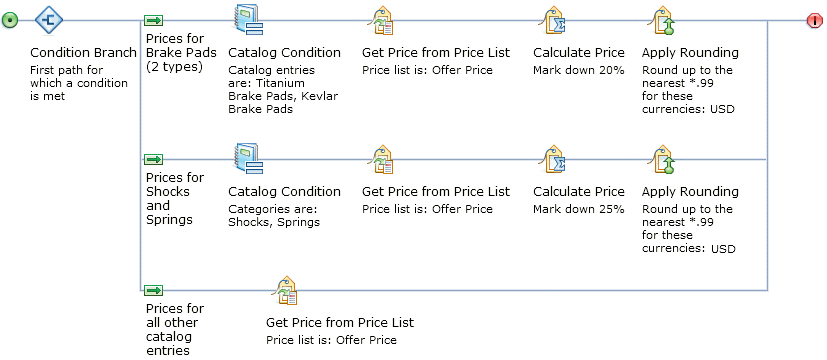

Scenario 3: B2B direct store with negotiated prices in contracts
The following scenario shows how a pricing manager for a B2B direct store might use price rules to provide various customers with standard or negotiated pricing. This scenario highlights the following price rule concepts: catalog conditions in price rules, and price rule reuse.
Site description
- Minelli Automotive, an auto parts supplier.
- Operates a single B2B direct store.
What the pricing manager wants to do
The pricing manager at Minelli Automotive wants to display different prices on the storefront, depending on who the customer is:- Guest and unregistered customers are entitled to prices in the Offer Price list (no markdowns). The Offer Price list contains a standard price for every catalog entry in the catalog.
- Four top customers have negotiated better pricing:
- Abe's Auto Service
- Gets 10% off the Offer Price list for everything in the catalog.
- Bob's Auto Service
- Gets the same prices as Abe's Auto Service.
- Chuck's Auto Service
- Gets 15% off the Offer Price list for everything in the catalog, except tires. For tires, the pricing manager maintains a separate price list containing Chuck's negotiated tire prices.
- Dave's Auto Service
- Gets prices from the Offer Price list for most of the catalog, but has negotiated 20% off certain brake pads and 25% off all shocks and springs.
How the pricing manager uses price rules
To achieve his pricing goals, the pricing manager creates a series of price rules and assigns them to the default contract for the store, and to various customer contracts, as shown in the following diagram:
- 1 Default contract for the store
For the store's default contract, the pricing manager creates and assigns a simple price rule called Offer Prices. On the storefront, this price rule displays the price from the Offer Price list as is. Guest and unregistered customers see these prices.
The Offer Prices price rule looks like this:
- 2 Abe's Auto Service
To provide Abe's buyers with 10% off the Offer Price list for everything in the catalog, the pricing manager creates a new price rule. He knows he can reuse this price rule for other customers, so he gives the price rule a generic name: 10% Markdown. He assigns the price rule to Abe's contract. As a result, buyers from Abe's Auto Service see prices calculated from this price rule on the storefront.
The 10% Markdown price rule looks like this:

- 3 Bob's Auto Service
To provide Bob's buyers with the same prices as Abe's buyers, the pricing manager assigns the 10% Markdown price rule to Bob's contract. This is the same price rule assigned to Abe's contract. As a result, buyers from Bob's Auto Service see prices calculated from the 10% Markdown price rule on the storefront.
- 4 Chuck's Auto ServiceThe pricing manager must provide Chuck's buyers with 15% off the Offer Price list with one exception: tires. For tires, the pricing manager has negotiated special prices that he maintains in a separate price list called Chuck's Tire Pricing. The pricing manager creates a new price rule called Chuck's Negotiated and assigns it to Chuck's contract. This price rule must set pricing differently, depending on whether the buyer is viewing:
- Tires, or
- Any other catalog entry in the catalog
To address these two conditions, the pricing manager uses a Condition Branch in the price rule to create two paths:- The first path sets tire prices.
- The second path sets prices for all other catalog entries in the catalog.
The Chuck's Negotiated price rule looks like this:
- 5 Dave's Auto ServiceTo manage pricing for Dave's Auto Service, the price manager creates a new price rule called Dave's Negotiated and assigns it to Dave's contract. Dave has negotiated pricing for certain parts of the catalog, but not for others:
- For Titanium Brake Pads or Kevlar Brake Pads, Dave gets 20% off the Offer Price list.
- For catalog entries from either the Shocks or the Springs category, Dave gets 25% off the Offer Price list.
- For all other catalog entries in the catalog, Dave gets the price from the Offer Price list.
To address these three conditions, the pricing manager uses a Condition Branch in the price rule to create three paths:- The first path sets prices for the two brake pad catalog entries.
- The second path sets prices for the Shocks and Springs categories.
- The third path sets prices for all other catalog entries in the catalog.

Highlights of this scenario
- You can save time by creating generic price rules that you can assign to more than one contract, as demonstrated for Abe's and Bob's contracts.
- You can use catalog conditions to calculate prices differently for specific parts of the catalog, as demonstrated for Chuck's and Dave's contracts.